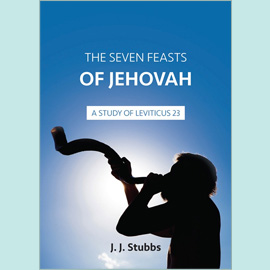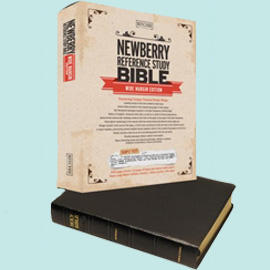
Above image: The Tabernacle in the wilderness
After their deliverance from Egypt the Lord command Israel to "make me a sanctuary; that I may dwell among them" (Ex 25.8). The importance of the subject is seen in that over fifty chapters in the Bible are devoted to the Tabernacle. Thirteen are in Exodus (chs.25-31; 35-40); eighteen in Leviticus (chs.1-10; 16-17; 21-25; 27); thirteen in Numbers (chs.1-9; 16-19), three in Deuteronomy (chs.16-18) and it is central to eight in Hebrews (chs.3-10). This far exceeds the chapters dealing with the Temple and reflects the value of the teaching that is associated with the Tabernacle. So great is this truth that although the creation of the universe is covered in two chapters in Genesis, the erection of the Tabernacle occupies such a large part of the book of Exodus. The great purpose of God centred on redemption.
The Plan
It must be understood that although there were temples built long before Israel left Egypt, the Tabernacle, the plan for this sanctuary, was unique. It was not an imitation of existing temples; it was not based on speculation as to what God would require; it was not the result of consultation with other religions as to what would suit the purpose of all. It was unique because it was built according to revelation. Moses received the instructions from the Lord while he was up the mount at Horeb (Ex 25.1-31.11). He was also shown a pattern of the divine plan (Ex 25.9,40).
Nothing was left to men to determine. The Lord appointed everything. In Exodus we learn that the command to build it came from Him (25.9) as did the instructions and pattern for every part of it. The materials to be used are set out in detail (25.3-7); the workmen who were to be responsible for the work, Bezaleel and Aholiab, were not only appointed to the task, but were given the skills and wisdom necessary to carry out the work (31.1-6). Those who would take part in the construction were also given the necessary wisdom (31.6). Direction was given as to where it had to be erected. The order in which the twelve tribes, the families of the Levites and the priests were to pitch their tents around it was laid out. There was nothing that was left to the wisdom or ingenuity of the people; all was ordained and directed by the Lord. It was the Tabernacle that was pitched by man (Heb 8.2), but everything was of the Lord.
The Purpose
The glorious invitation to make a sanctuary fell on the ears of Moses as the God who had delivered them from the sore bondage of Egypt declared that His desire was to dwell in their midst. There was a fourfold purpose in this. First, it was that there would be divine glory in the midst of His redeemed people; the second, that there would be divine government amongst His people; the third, that there might be divine guidance for the pathway of His people; the fourth, that Israel would come to understand more of the divine grace with which He dealt with His people.
On more than one further occasion the Ark, which was in the Holiest of All, is stated to be the dwelling place of the Lord, He who dwelt between the cherubims which were upon the Mercy Seat there. The prophet speaks of it as such: "O Lord of hosts, God of Israel, that dwellest between the cherubims, thou art the God, even thou alone, of all the kingdoms of the earth: thou hast made heaven and earth" (Is 37.16).
But not only was the Tabernacle the place when God dwelt in their midst, it was also the place to which the people would come to show devotion to the Lord. This was done by the bringing of the sweet savour sacrifices (burnt, meal, and peace offerings) and by bringing the sacrifices necessary to deal with their sins (sin and trespass offerings).
But what about this Sanctuary today? Without the detail of the Tabernacle it would be impossible to understand the book of Leviticus and the worship which is ordered there. Without the Tabernacle the sacrifices could not be offered and the priesthood could not carry out the duties with which they were charged. The Temple, built during the reign of Solomon, does not, as has been noted, take as many pages to describe as the Tabernacle, and it is through the latter that a greater understanding of the Temple can be gained. The Temple was a more permanent structure, based upon the Tabernacle, and its essential features are the same as those associated with the Tent of Meeting erected by Moses. The Epistle to the Hebrews would almost be a closed book to the reader if there were no knowledge of the Tabernacle, as the teaching is to a great extent built on the service which took place there, with particular emphasis on the Day of Atonement.
The Place
The Tabernacle was erected in the middle of the Camp of Israel. All the tribes gathered round it. Speculation as to the area covered by the Camp of Israel varies. Some assert that it would be seven miles in length and breadth, some that it was fourteen miles. No matter where the answer lies, the Tabernacle was the central point in the Camp so that Israel would be conscious of the Lord being in their midst. It was, therefore, the centre point of their lives. They would be constantly reminded of this as there was a cloud that denoted the presence of God.
This was the first divinely given system of united public worship, and as such was a further stage in the revelation of God. Up to this point sacrifices had been offered by Abel (Gen 4.4), Noah (Gen 8.20-22), Abraham (Gen 22.13), Job (Job 1.5), Jacob (Gen 31.54), and doubtless by many others. Now, for the first time there is a recognised redeemed nation whose God is the Lord, and therefore it is necessary to have an order of approach to the Lord, and of worship, set forth by Him.
The Priesthood
As the priesthood functioned it taught necessary lessons. These included the holiness that must mark the House of God and those who approach Him; the importance of the priesthood associated with it; the functions and the glories associated with the High Priest; the nature of the sacrifices which the Lord desired to have offered. All this was designed to teach Israel how to worship and to enjoy the presence of the Lord in the midst.
The priests were appointed by the Lord from the tribe of Levi. The first High Priest was Aaron, the brother of Moses, and succeeding generations of that family enjoyed the privilege of the priestly office and were charged with honouring its responsibilities. The remainder of the tribe of Levi were appointed as servants in the Tabernacle.
The Privilege
The great promise made was, with reference to the Tabernacle, "There I will meet with the children of Israel, and the tabernacle shall be sanctified by my glory" (Ex 29.43). Not only had He delivered them from bondage, but He would be with them, not at a distance, but in their midst. The Tabernacle was a place unique amongst nations. It was "sanctified", that is "set apart" from all others places, by the presence of God. This uniqueness was not a factor of the place itself, but rather of the One who dwelt there. The uniqueness moved with Him.
The Pattern
The Tabernacle and what took place in it is "the shadow of heavenly things" (Heb 8.5). Vine states that the word for "shadow" means that which is "caused by the interception of light…the image or outline cast by an object". It is an image created by an object when light is shone on it. In order to create a shadow there must be a real object and there must be light. The image which is cast is a shape of reality but lacks one dimension, that of depth, and is devoid of all colour (see Heb 8.5; 10.1). It has no substance of itself but requires the real thing to be in existence. In heaven there is the Sanctuary, and the Tabernacle which was on earth was a shadow, albeit a pale shadow, of the heavenly.
The "real thing", of which the Tabernacle is an example, a shadow, is heaven itself and heavenly things. It is, therefore, a figure of heavenly things, not earthly things; it is a representation of the true. Here, in a form which can be understood by men and women, is pictured how to approach God and have fellowship with Him, the reality of which is found, not in that Tabernacle made with hands, but in the true Tabernacle above, which the Lord pitched and not man. Anyone with a desire to learn more of heavenly things must study the Tabernacle. These Scriptures all confirm that "the Tabernacle and its furniture are meant to be studied as an object lesson illustrating deep and abiding reality. The substance is the heavenly sanctuary where Christ ministers…it may be observed that there is every justification for concluding that in the Tabernacle we may find ample material as a prefigurement of Christ and His work for His people, the new Israel of God" (Andrew Borland).









